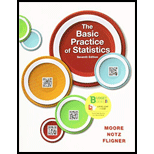
Concept explainers
(a)
To find: The probability of exactly one infection among the 17 vaccinated children.
To obtain: The probability of exactly one infection among the 3 unvaccinated children.
To calculate: The probability of exactly one infection in each group.
(a)
Answer to Problem 14.41E
The probability of exactly one infection among the 17 vaccinated children is 0.3741.
The probability of exactly one infection among the 3 unvaccinated children is 0.0960.
The probability of exactly one infection in each group is 0.0359.
Explanation of Solution
Given info:
There is a group of 20 children in the nursery school who are exposed to whooping cough by playing with an infected child. Among these children, 17 have been vaccinated and 3 are unvaccinated.
Calculation:
The random variable “U” represents ‘the number of unvaccinated children who have been exposed to whooping cough will develop the infection’. Here, the random sample of 3(n) children has been randomly chosen as being exposed.
Also, there are two possible outcomes (develop the infections and do not develop the infections) with the probability of success ‘the chance that the unvaccinated children who been exposed to whooping will develop the infections (p) is 0.80’ and ‘the unvaccinated children who been exposed to whooping cough will not develop the infection is 0.20
The random variable “V” represents ‘the number of vaccinated children who have been exposed to whooping cough will develop the infection’. Here, the random sample 17(n) children have been randomly chosen being exposed.
Also, there are two possible outcomes (develop the infections and do not develop the infections) with the probability of success ‘the chance that the vaccinated children who have been exposed to whooping cough will develop the infection (p) is 0.05’ and ‘the vaccinated children who been exposed to whooping cough will not develop the infection is 0.95
The probability of exactly one infection among the 17 vaccinated children:
The probability using binomial distribution is given by,
Substitute n as 17, p as 0.05 and q as
That is,
Thus, the probability of exactly one infection among the 17 vaccinated children is 0.3741.
The probability of exactly one infection among the 3 unvaccinated children:
Substitute n as 3, p as 0.80 and q as
That is,
Thus, the probability of exactly one infection among the 3 unvaccinated children is 0.0960.
The probability of exactly one infection in each group:
The
By the independent condition between the two events,
Thus, the probability of exactly one infection in each group is 0.0359.
(b)
To find: The probability of exactly two infections in each group.
(b)
Answer to Problem 14.41E
The probability of exactly two infections in each group is 0.1978.
Explanation of Solution
Calculation:
The probability of two infections among the 17 vaccinated children:
Substitute n as 3, p as 0.80 and q as
Substitute n as 17, p as 0.05 and q as
The possibilities are listed below:
Consider,
Consider,
Therefore,
Thus, probability of exactly two infections in each group is 0.1978.
Want to see more full solutions like this?
Chapter 14 Solutions
Loose-leaf Version for The Basic Practice of Statistics 7e & LaunchPad (Twelve Month Access)
 MATLAB: An Introduction with ApplicationsStatisticsISBN:9781119256830Author:Amos GilatPublisher:John Wiley & Sons Inc
MATLAB: An Introduction with ApplicationsStatisticsISBN:9781119256830Author:Amos GilatPublisher:John Wiley & Sons Inc Probability and Statistics for Engineering and th...StatisticsISBN:9781305251809Author:Jay L. DevorePublisher:Cengage Learning
Probability and Statistics for Engineering and th...StatisticsISBN:9781305251809Author:Jay L. DevorePublisher:Cengage Learning Statistics for The Behavioral Sciences (MindTap C...StatisticsISBN:9781305504912Author:Frederick J Gravetter, Larry B. WallnauPublisher:Cengage Learning
Statistics for The Behavioral Sciences (MindTap C...StatisticsISBN:9781305504912Author:Frederick J Gravetter, Larry B. WallnauPublisher:Cengage Learning Elementary Statistics: Picturing the World (7th E...StatisticsISBN:9780134683416Author:Ron Larson, Betsy FarberPublisher:PEARSON
Elementary Statistics: Picturing the World (7th E...StatisticsISBN:9780134683416Author:Ron Larson, Betsy FarberPublisher:PEARSON The Basic Practice of StatisticsStatisticsISBN:9781319042578Author:David S. Moore, William I. Notz, Michael A. FlignerPublisher:W. H. Freeman
The Basic Practice of StatisticsStatisticsISBN:9781319042578Author:David S. Moore, William I. Notz, Michael A. FlignerPublisher:W. H. Freeman Introduction to the Practice of StatisticsStatisticsISBN:9781319013387Author:David S. Moore, George P. McCabe, Bruce A. CraigPublisher:W. H. Freeman
Introduction to the Practice of StatisticsStatisticsISBN:9781319013387Author:David S. Moore, George P. McCabe, Bruce A. CraigPublisher:W. H. Freeman





